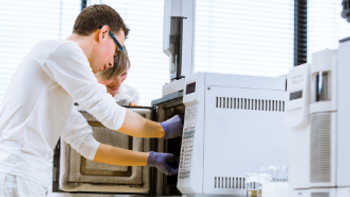
The Potential of SEC-MALS in Monitoring Gene Therapy
Bryan Troxell and other StrideBio scientists used size-exclusion chromatography with UV and multiangle light scattering (SEC-MALS) to measure changes in different viruses.
In a 2023 study from StrideBio scientists, Bryan Troxell and his colleagues tested the effectiveness of size-exclusion chromatography with UV and multiangle light scattering (SEC-MALS) in monitoring changes in adeno-associated viruses (AAV). Their findings were published in the journal Human Gene Therapy (1).
AAVs have become notable vehicles for treating human genetic diseases because they are nonpathogenic, have lower immunogenicity than most viruses, and can transduce different types of cells. There are over 100 ongoing clinical trials in the United States to use recombinant AAV (rAAV) to correct genetic diseases via genetic cargo. Properly manufacturing rAAV relies on different genetic components being provided in trans, such as Rep and Cap genes, target DNA flanked by inverted terminal repeats (ITRs), and adenovirus helper genes.
Unfortunately, product-related impurities, such as empty rAAV capsids, can lead to side effects when administered to humans. To minimize the presence of empty capsids, accurate analytical methods must be implemented early in the product development process. For this procedure, the scientists used a process confirmation vector, made from 200 L production, to develop a SEC-MALS method that can eliminate or drastically reduce product-related impurities. Furthermore, the full-to-empty ratio of capsids was also measured with SEC-MALS, sedimentation velocity analytical ultracentrifugation (SV-AUC), droplet digital PCR (ddPCR) with capsid enzyme-linked immunosorbent assay (ELISA) with a bulk absorbance at 260–280 nm, and cryogenic electron microscopy. These procedures were used for a 30-day, non-Good Laboratory Practices (GLP) animal study that assessed the biodistribution of the product, STRX-330, with method development being performed with an isocratic mobile phase and two separate SEC analytical columns.
Of the different methods involved, SEC-MALS outperformed the other methods and correlated well with the sedimentation velocity (SV-AUC) values of full-to-empty particles. SEC-MALS generally performed similarly to or better than other methods, all while achieving linear, accurate, and precise chromatography quality control (QC) recommendations. When treated to alkaline stress, SEC-MALS indicated distinct changes in the DNA content of the monomer AAV peak for STRX-330; as for acidic treatment, while there was a more aggregated vector, the DNA content was not affected. Overall, SEC-MALS proved to be a valuable tool in the analytical development and QC testing of AAV, while possibly being useful in understanding how AAV react to environmental stress. These findings can help manufacturers minimize conditions that can reduce overall performance.
Reference
(1) Troxell, B.; Tsai, I-W.; Shah, K.; Knuckles, C. I.; Shelton, S.; Lindsey, K.; Barbosa Cardenas, S. M.; Roberts, T. Application of Size Exclusion Chromatography with Multiangle Light Scattering in the Analytical Development of a Preclinical Stage Gene Therapy Program. Hum. Gene Ther. 2023, 34 (7–8). DOI:
Newsletter
Join the global community of analytical scientists who trust LCGC for insights on the latest techniques, trends, and expert solutions in chromatography.




